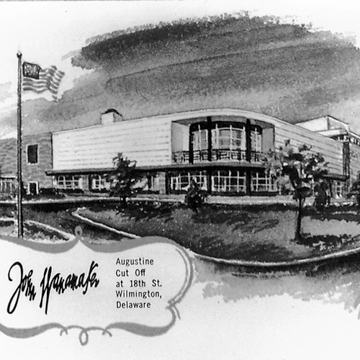You are here
Office Building (John Wanamaker Store)
The postwar shift of retail to suburbia was epitomized by the construction of a huge department store in a field outside the Wilmington city limits. Construction proceeded rapidly, with some 300 men employed. Plans were changed in the middle of the process to double the sales space, as a study predicted high local demand. The smooth, streamlined exterior, which culminated in a rounded corner above the downhill entrance, was of Avondale granite and pink-buff Mansota veined marble, with extensive plate glass windows and chrome detailing. A heating system under the sidewalks melted snow. The interior featured escalators, year-round climate control and air conditioning, and both incandescent and fluorescent lighting. The store's Ivy Tea Room overlooked Brandywine Creek. Key to the success of such isolated, “lone wolf” stores was a huge parking lot; the one for this building is sufficient for 750 cars, arranged on different levels. The successor firm to Massena and du Pont designed an addition in the early 1960s. Pioneering the suburban-retail model, Wanamaker's was followed closely by Wilmington Merchandise Mart at Edgemoor (1951–1952, Albert D. Lueders). By the end of the twentieth century, newer malls had long since supplanted these early centers; Merchandise Mart was virtually abandoned, with demolition contemplated, and Wanamaker's was converted into corporate offices by a Houston-based firm, with a colorful new Postmodern interior.
Writing Credits
If SAH Archipedia has been useful to you, please consider supporting it.
SAH Archipedia tells the story of the United States through its buildings, landscapes, and cities. This freely available resource empowers the public with authoritative knowledge that deepens their understanding and appreciation of the built environment. But the Society of Architectural Historians, which created SAH Archipedia with University of Virginia Press, needs your support to maintain the high-caliber research, writing, photography, cartography, editing, design, and programming that make SAH Archipedia a trusted online resource available to all who value the history of place, heritage tourism, and learning.











